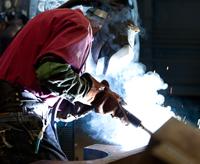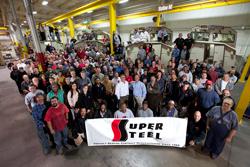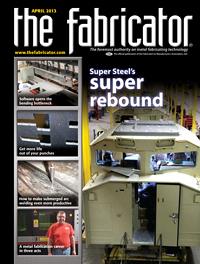Senior Editor
- FMA
- The Fabricator
- FABTECH
- Canadian Metalworking
Categories
- Additive Manufacturing
- Aluminum Welding
- Arc Welding
- Assembly and Joining
- Automation and Robotics
- Bending and Forming
- Consumables
- Cutting and Weld Prep
- Electric Vehicles
- En Español
- Finishing
- Hydroforming
- Laser Cutting
- Laser Welding
- Machining
- Manufacturing Software
- Materials Handling
- Metals/Materials
- Oxyfuel Cutting
- Plasma Cutting
- Power Tools
- Punching and Other Holemaking
- Roll Forming
- Safety
- Sawing
- Shearing
- Shop Management
- Testing and Measuring
- Tube and Pipe Fabrication
- Tube and Pipe Production
- Waterjet Cutting
Industry Directory
Webcasts
Podcasts
FAB 40
Advertise
Subscribe
Account Login
Search
The comeback metal fabricator
How Super Steel rebounded from receivership
- By Tim Heston
- April 8, 2013
- Article
- Shop Management

Figure 1: Super Steel is a hybrid—part contract fabricator, part product-line manufacturer of highly engineered assemblies, specifically freight rail locomotives.
Super Steel owns an empty 180,000-sq.-ft. plant in Milwaukee. A for-sale sign hangs on the gate. This could be seen as a remnant of the overleveraged, pre-financial-crisis era. The fabricator exited receivership several years ago. The financial crisis forced the company to downsize significantly, from a head count high of 650 in 2008 to only 185 in the beginning of 2010.
But then you look at its bustling main facility a few miles away, all 450,000 sq. ft. of it. Today this plant alone has the capabilities to generate more than double the revenue produced previously from three facilities—two in Milwaukee and one in Glenville, N.Y., near Schenectady. In the months and years since the financial crisis, the organization has transformed.
Super Steel went back to its roots of quick-turn contract fabrication and successfully balanced it with its product line work for the freight rail industry. In short, the company found the right mix of people and work to grow. Managers expect revenues to reach $70 million by the end of 2013.
It’s been a productive three years.
Leveraging Out
Launched back in 1923, the company was purchased by Fred Luber in 1966. Over the years he built the fabricator on quick-turn, contract metal fabrication and, in later years, expanded into the freight rail business, producing cabs for locomotives. By 2005 Luber, then in his 70s, was looking to retire. His son Paul had grown up in the business but had since gone on to operate contract manufacturers of his own. So his father sold the business to the management team in a highly leveraged deal.
As sources explained, Super Steel’s downfall came as a result of business decisions that in hindsight look extremely risky. But 2005 was a different time. Super Steel had built a name for itself in the freight rail arena (see Figure 1), and managers at the time wanted to extend those capabilities to the passenger rail sector. The company entered a joint venture with EMD, or Elecro-Motive Division, which before the recession was part of General Motors’ locomotive business, and purchased a plant near Schenectady, N.Y., to ramp up its passenger rail work.
It turned out that the highly regulated passenger rail business was entirely different from the freight arena. But even if this weren’t the case, Super Steel was in trouble. To those in contract fabrication—including the managers at Super Steel—building steady product-line work can look incredibly attractive. But as the credit markets froze in 2009, so did Super Steel’s product-line work in the rail sector. With so much revenue dependent on that work, the fabricator’s finances quickly went on life support.
In 2010 Fred Luber bought back the business. As his son Paul recalled, “Dad had a lot in the buyout [in 2005]. He had funded a good portion of it; he was a major secured lender going into it. And when it went into receivership, it was his wish to repurchase, restart, and get the business back on track. Over the years, it had been such a big part of his professional working life. He has a passion for it.”
“He had spent more than 40 years of his life here, and he didn’t want to see it purchased, cannibalized, and shut down,” said Dirk Smith, president and COO.
One more thing: When Fred bought back the business, he was 85.
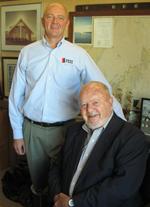
Figure 2: Fred Luber, now 88, repurchased the business in 2010. His son Paul (left) became CEO, and President and COO Dirk Smith was hired to manage day-to-day operations.
Today company shares are in a family trust. Fred remains chairman; his son Paul is the CEO (see Figure 2). Paul went to school for mechanical engineering, got his MBA and delved into the capital markets business, then circled back to manufacturing in the late 1990s and purchased an HVAC products company.
“This started me down the entrepreneurship path, and I’m still involved in several small and medium-sized manufacturing businesses,” he said. “From high school, being on the shop floor at Super Steel, and throughout the past 24 years, I’ve been active in the ownership of manufacturing companies. I’ve participated in quite a few turnarounds and restructurings myself. And it’s a space I’m comfortable in; I like it.”
Paul knew he needed a leadership team to carry out the turnaround, and this is where Smith came into the picture. Smith previously co-owned Custom Metal Products and Phoenix Coaters, both purchased by Mayville Engineering Co. (a company that has topped this magazine’s Fab 40 list for several years running).
“I’ve known Dirk for more than 10 years,” Paul said. “We met as metal fabricating competitors but built a relationship through common customers and getting to know each other at industry events.” And so Smith was brought on to run the day-to-day operations.
Back to the Shop’s Roots
Super Steel is a hybrid. One part focuses on short-run, quick-turn fabrication of products ranging from subassemblies to short-run, whole-goods work, in which the fabricator takes on the entire manufacturing process and shipping for a customer. Another part focuses on complex, highly engineered, make-to-order product-line manufacturing—specifically freight locomotives. This involves not only welding and fabrication, but also electromechanical assembly.
Managers knew they didn’t want to abandon the rail industry altogether. Over the years, the shop had built a good reputation for its engineering and shop floor expertise. “But we wanted to shift the organization from what was a one-cylinder engine to more of a V8, serving multiple industries and multiple customers,” Paul said. “We wanted a much more diverse platform.”
The receivership lasted several months, ending in May 2010. During this period, the company communicated everything and remained extremely transparent with its customers and vendors. “We needed to tell our customers where we were at, and where we were going,” Paul said. “No customers were lost during the receivership.”
Super Steel had a new leadership team in place; a longtime owner who had built up customer trust over the years had thrown his hat back into the game; and the company had a plan to diversify, to build its contract fabrication business while retaining its presence in freight rail. All this, Paul said, buttressed customer confidence.
By its nature, contract fabrication benefits from short order-to-cash cycles, at least compared to some sectors, locomotive manufacturing being one of them. For contract work, a customer places an order for a few dozen subassemblies, the product ships several weeks later, and the cash flows into the business. Super Steel’s rail business, however, entailed months-long lead-times and intricate supply chain collaboration. The work was steady, but the company invested in a lot of engineering, labor, and material in the interim.
“Coming out of the receivership, we got our cost structure aligned, sold the facility in New York, reorganized the operations, and invested about $4 million in new equipment and an ERP [enterprise resource planning] platform,” Smith said.

Figure 3: Super Steel had nested dynamically for years, but now the nest only has parts needed in the near-term.
This included spending for machine tools, building upgrades, and (especially) software. The capital spending this year continues unabated, Smith said, adding that he expected total spending to be about $2.5 million.
Process Improvement
Aligning cost structures, selling facilities, reorganizing operations—all are standard tools for a company coming back from the brink. But what about the capital investments? As sources explained, the investment was necessary to help shorten that order-to-cash cycle and drive efficiency.
The length of those order-to-cash cycles is driven in part by customers and the type of work they do. Although it exited the passenger rail business, Super Steel remains a major supplier for the freight rail sector. The orders entail thousands of different parts and complex fabrication and assembly, and that prolongs lead-time.
Still, shop floor inefficiencies also prolong lead-time, so the company looked inward and analyzed material movement. Where did material sit, and for how long? The longer that material spent sitting or being transported between operations, the longer it took to get a product through manufacturing—and the longer the lead-time would be.
During the restructuring the company consolidated its operations, moving everything to one building. The 180,000-sq.-ft. building down the street previously acted as a staging area for work-in-process. Parts would be cut, bent, sent to the other plant to be kitted, then sent back to the other facility for final welding, assembly, and finishing.
That’s a lot of wasted motion, so much in fact that managers have no plans to use the building as a manufacturing facility again—hence the for-sale sign on the front gate. As Smith explained, the main plant has enough capacity to fabricate up to about $100 million worth of products in a year. “So we have room to grow within our existing footprint.” And if the company were to grow past this, it has room to build additional buildings adjacent to its main plant.
Super Steel also reached out to its sheet metal and plate supply base to reduce its raw stock inventory. The company now benefits from quick delivery from several service centers. “Previously we would have sheet metal stacked high,” Smith said. “Now we’ve partnered with two of our service centers. If we e-mail them at 2:30 p.m., they can have the order on the truck the next morning. As a result, we’ve turned our raw stock inventory space into productive space. The space that used to be tied up in inventory dollars is now being used to generate revenue.”
“We’re lucky. A lot of steel distribution has come into our region,” Paul said.
From raw stock, material is fed to the cutting systems, which include seven laser cutting centers, one plasma cutting table (see Figure 3), and one oxyfuel system. But products flow differently than before. For years Super Steel had employed dynamic nesting, with disparate parts nested together on one sheet or plate. But instead of looking 14 days out on the schedule, the company now only nests parts needed over the next seven days.
“We’re able to get 90 percent or better sheet utilization,” said Smith. “So our utilization actually went up, our throughput went up, and our batch sizes got smaller.”
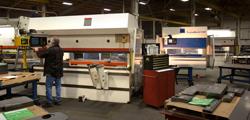
Figure 4: The company reduced setup time at its press brakes to handle smaller batches and streamline part flow.
Smaller batch sizes call for faster setups. To accomplish this in the press brake area, workers purged unused tools and developed standardized work instructions (see Figure 4). The scheduling system groups like jobs for the day together, so operators can run similar setups one after another. “If I have a single-hit, 0.375-in.-radius, 90-degree bend, the system will show me all the jobs available that use that setup,” Smith said.
Parts then flow to a kitting area—the operation’s heartbeat. Here, parts are kitted and sent to welding and assembly cells downstream. Some flow to an area dedicated to rail industry fabrication, while the remaining pieces flow to flexible assembly cells set up for a range of products.
Hiring Talent
The company considers welding as its core competency, with extensive in-house training and its own welding school (see Figure 5). “About 40 percent of our direct labor costs involves welding,” Smith said.
But how does Super Steel—a company just three years out of receivership—attract talent, especially in a place like Milwaukee, where people skilled in metal fabrication have options? “We are a big believer in pay for performance,” Smith said. “We changed our incentive program away from an across-the-board 3 percent raise to one that’s based on performance, as measured by attendance and productivity. If you’re a performer, you’re going to rise up.”
Leading up to the receivership, workers had endured years without pay increases and some pay reductions. Now, according to the company, Super Steel offers very competitive wages—and we’re not talking about just 50 cents more an hour.
“We pay better than most in our area,” Smith said. “For some positions, we’re talking about $5 additional an hour. Over a 40-hour workweek, that’s $200 more. What does it cost you to have a poor performer in quality, in delivery, in rework? It costs far more than $200.”
The pay attracts the talent, but that’s only the starting point. From here, managers work to nurture the talent, based in part on a person’s technical skills, in part on soft skills. Those who have leadership skills—that is, those who bring improvement suggestions to the table and communicate well with others—often are made what Super Steel calls “tech leaders,” who lead improvement activities in certain departments. Smith noted that these people might not be the best machine operators or welders. A top notch welder without a torch is like a painter without a brush. The best welders often are happiest doing what they do best.
“Previously a lot of people didn’t know what was expected of them,” Smith said. “So we defined roles and responsibilities, and we assessed our talent to ensure we have the right people in the right role. And some people left the organization as a result of that. But I’m a firm believer that to be the best, we have to employ the best. So we hired some good people, and those people tell their friends. They’ve been our best recruiters—and that has allowed us to be successful.”
In a 2012 financial benchmarking survey from the Fabricators & Manufacturers Association Intl. (FMA), fabricators reported their direct labor as a percentage of sales. The average was 13 percent. Conversely, material costs as a percentage of sales was about 35 percent. And according to a 2009 survey from FMA, a correlation exists between high inventory turnover, high returns on net assets, and a shop’s profitability.
Translation: Direct labor costs certainly factor into the equation, but process efficiency plays a bigger role. The more efficiently a shop can turn expensive material into things of value, the more successful it can be.
Paying for Talent Pays Off
During the credit crisis, Super Steel looked as if it would meet the same fate of so many businesses. It relied on one sector for a good portion of its revenue. It overleveraged to expand. But it turned around. Its freight rail business has long lead-times and entails complex assemblies, but provides consistent work and so helps smooth out the peaks and valleys of customer demand in contract fabrication, which in turn provides the market diversity.
“We’ve moved beyond rail,” Smith said. “We’re heavily in agriculture, mining, construction—we touch all the players, so diversification has been a big component of our success.”
The year Super Steel went into receivership, 2010, the fabricator made $27 million and employed 185. Now the fabricator employs more than 400 (see Figure 6). In just a year revenue doubled from its low during the receivership.
Moving forward, managers said they expect the company to grow 10 to 15 percent annually over the next several years. Super Steel now ships products nationwide as well as to Mexico—all this from a workforce that makes far above the average wage in a city that’s one of this industry’s most concentrated, competitive areas.
“Labor costs are certainly meaningful,” Paul said, “but it’s a small wedge of the pie. We employ very motivated, focused, skilled folks on our shop floor who are getting paid a better-than-market wage, and we give them the tools to thrive. At the end of the day, we can knock it out better, faster, and for less money than someone who is pinching pennies on payroll.”
About the Author

Tim Heston
2135 Point Blvd
Elgin, IL 60123
815-381-1314
Tim Heston, The Fabricator's senior editor, has covered the metal fabrication industry since 1998, starting his career at the American Welding Society's Welding Journal. Since then he has covered the full range of metal fabrication processes, from stamping, bending, and cutting to grinding and polishing. He joined The Fabricator's staff in October 2007.
subscribe now

The Fabricator is North America's leading magazine for the metal forming and fabricating industry. The magazine delivers the news, technical articles, and case histories that enable fabricators to do their jobs more efficiently. The Fabricator has served the industry since 1970.
start your free subscription- Stay connected from anywhere

Easily access valuable industry resources now with full access to the digital edition of The Fabricator.

Easily access valuable industry resources now with full access to the digital edition of The Welder.

Easily access valuable industry resources now with full access to the digital edition of The Tube and Pipe Journal.
- Podcasting
- Podcast:
- The Fabricator Podcast
- Published:
- 04/16/2024
- Running Time:
- 63:29
In this episode of The Fabricator Podcast, Caleb Chamberlain, co-founder and CEO of OSH Cut, discusses his company’s...
- Industry Events
16th Annual Safety Conference
- April 30 - May 1, 2024
- Elgin,
Pipe and Tube Conference
- May 21 - 22, 2024
- Omaha, NE
World-Class Roll Forming Workshop
- June 5 - 6, 2024
- Louisville, KY
Advanced Laser Application Workshop
- June 25 - 27, 2024
- Novi, MI
























